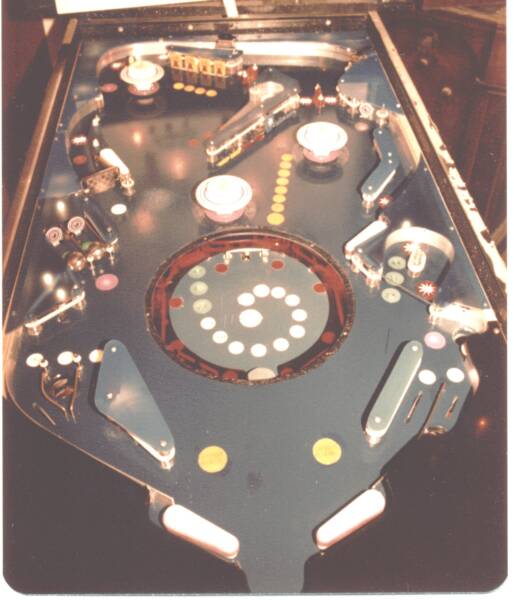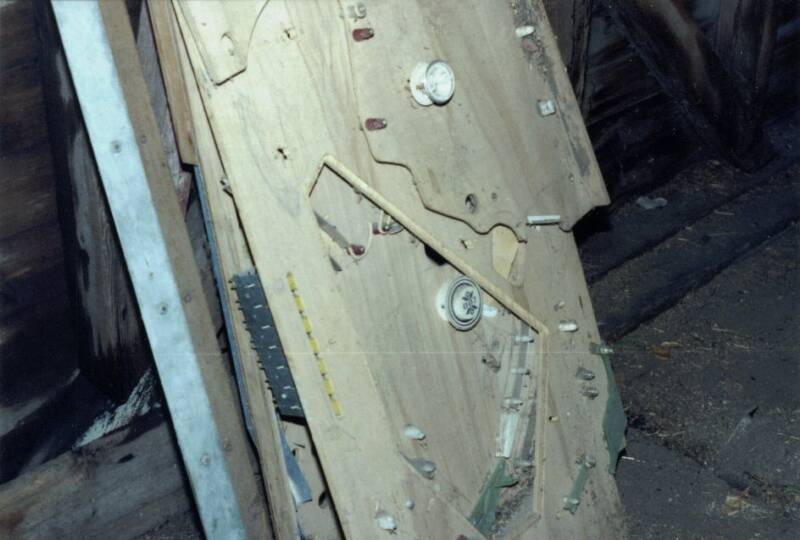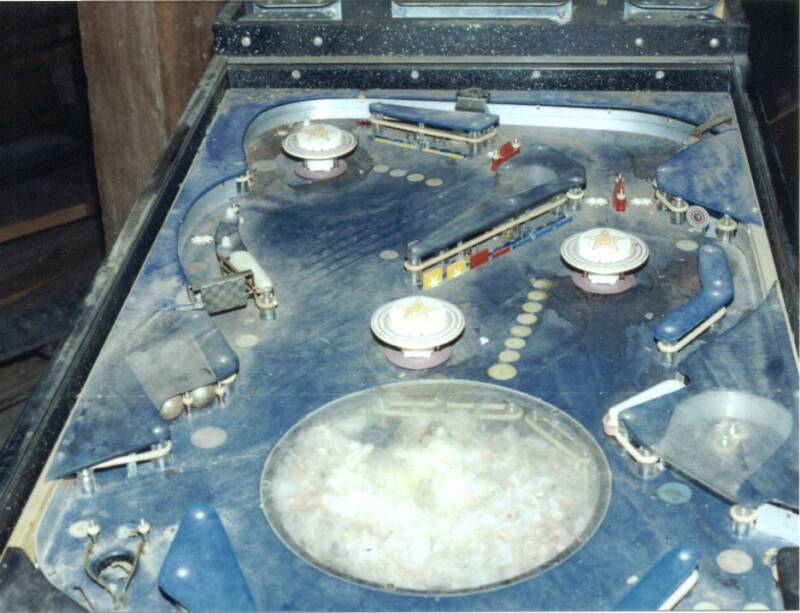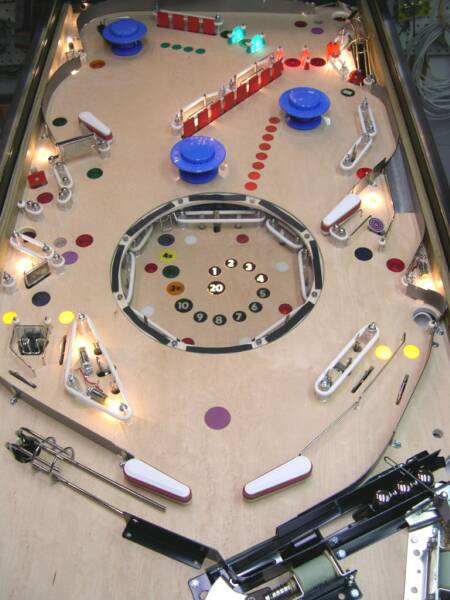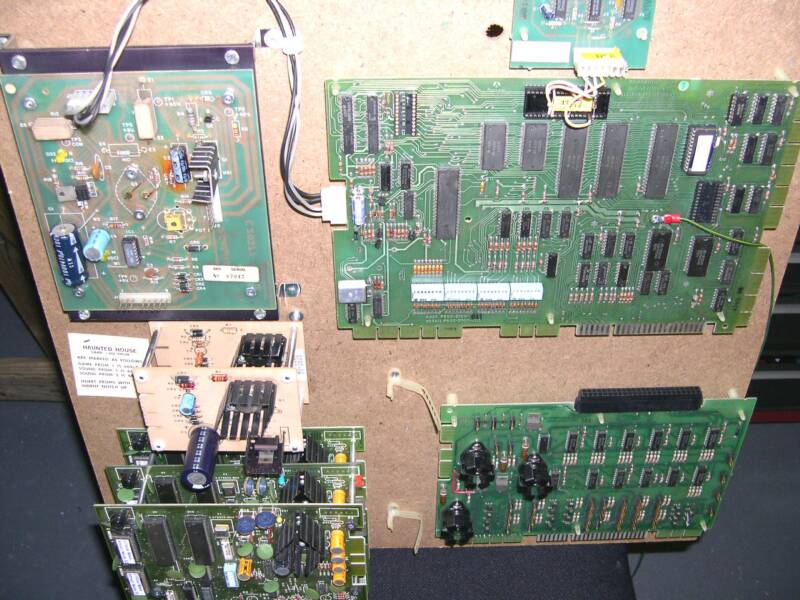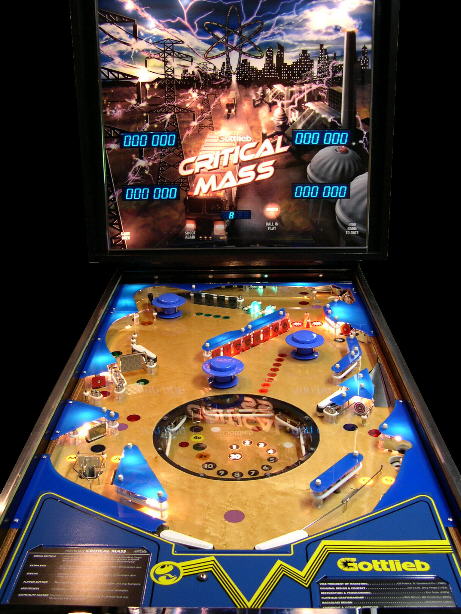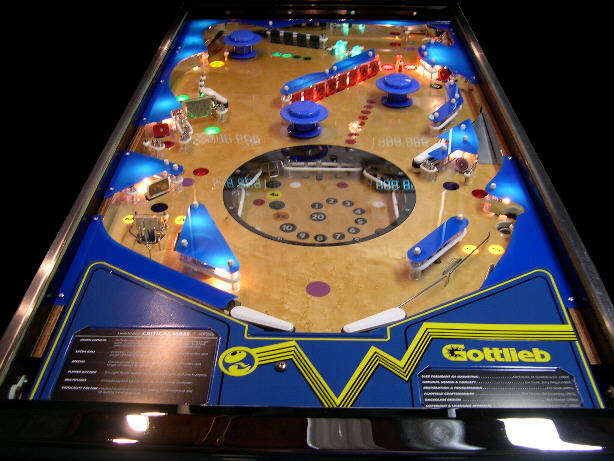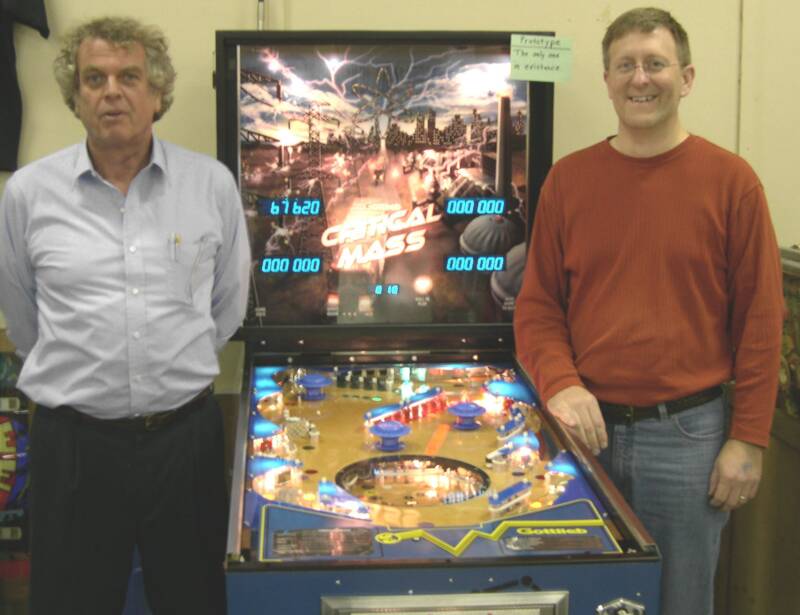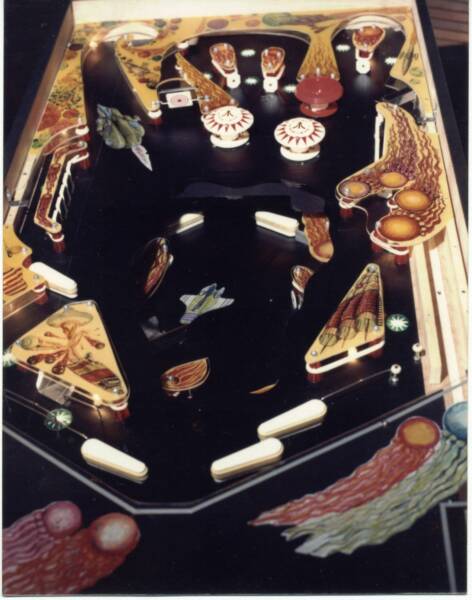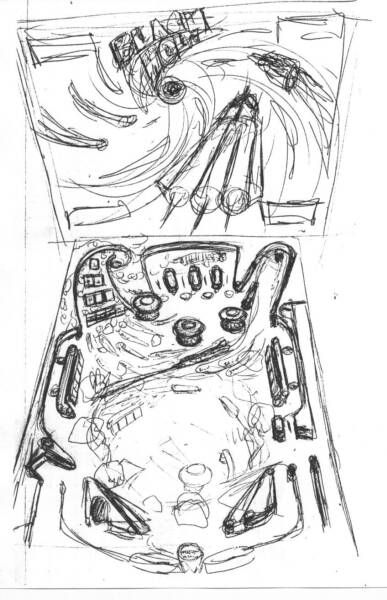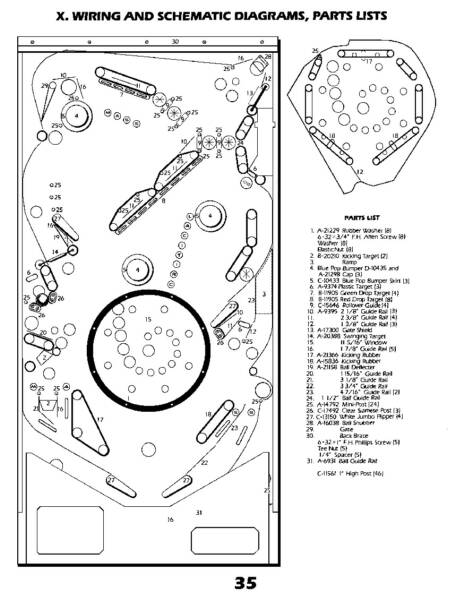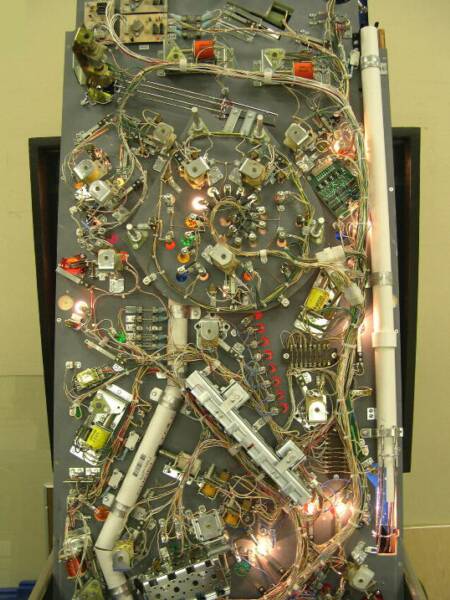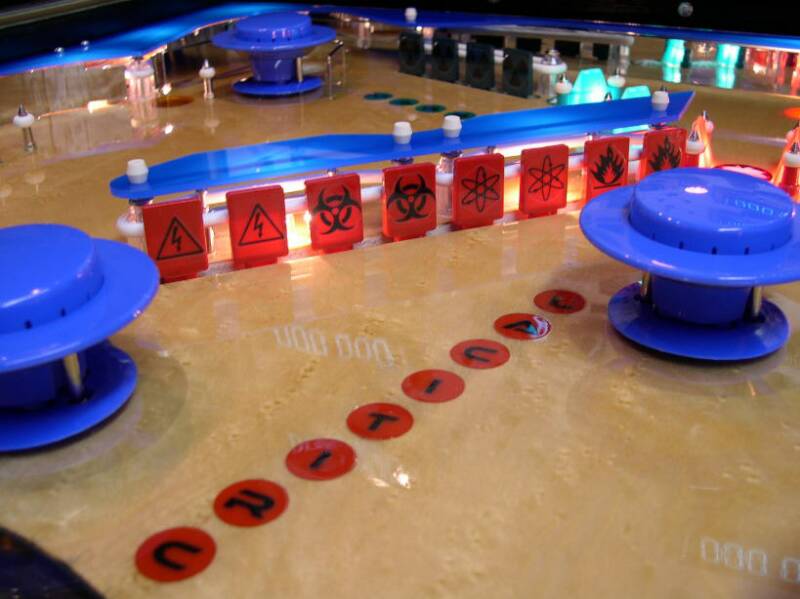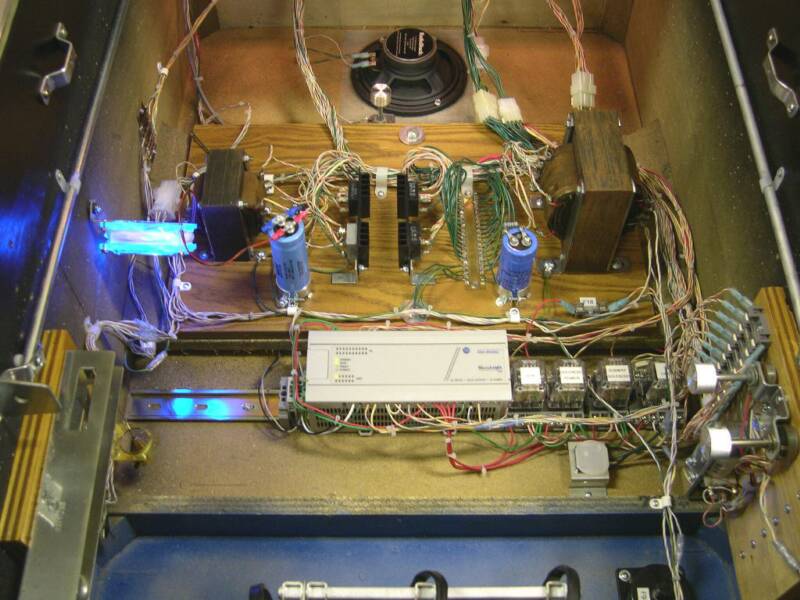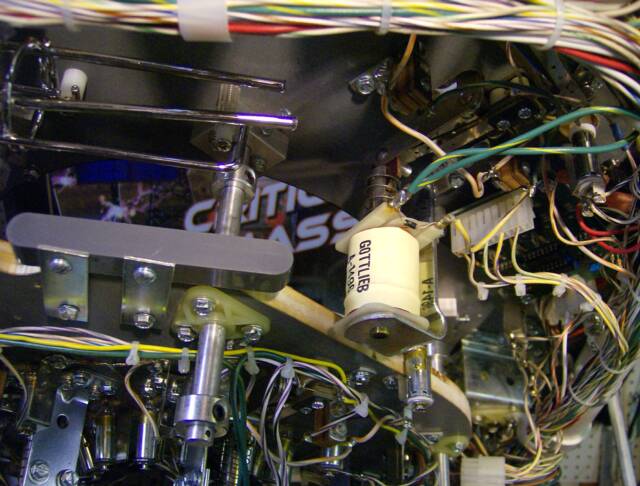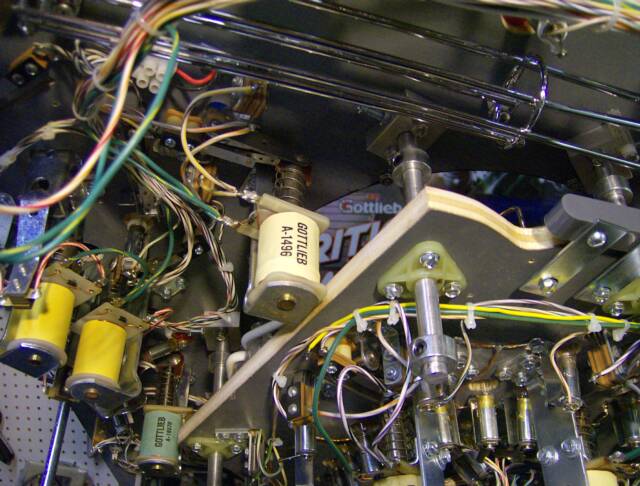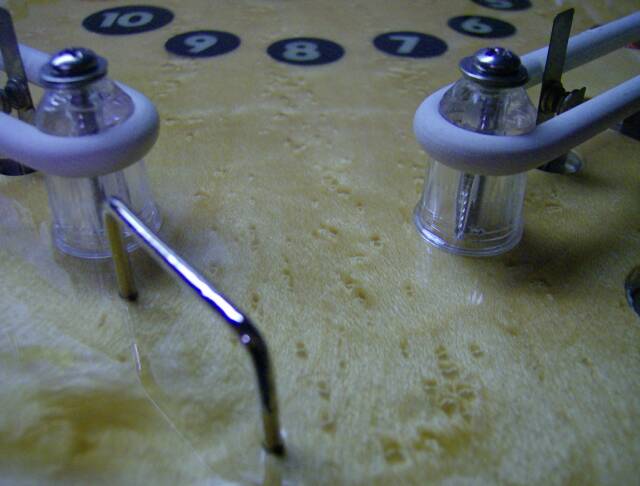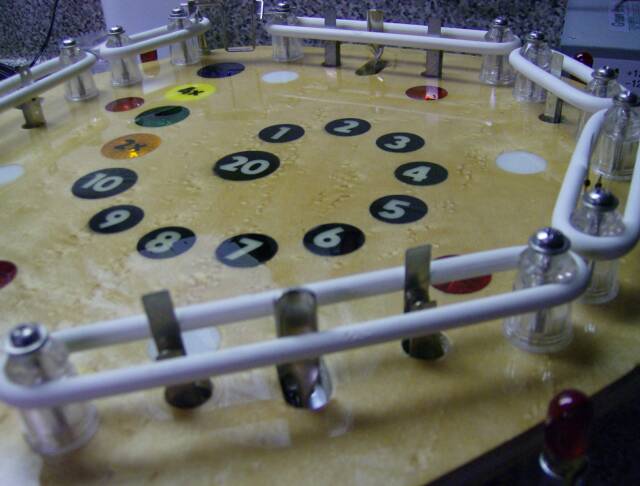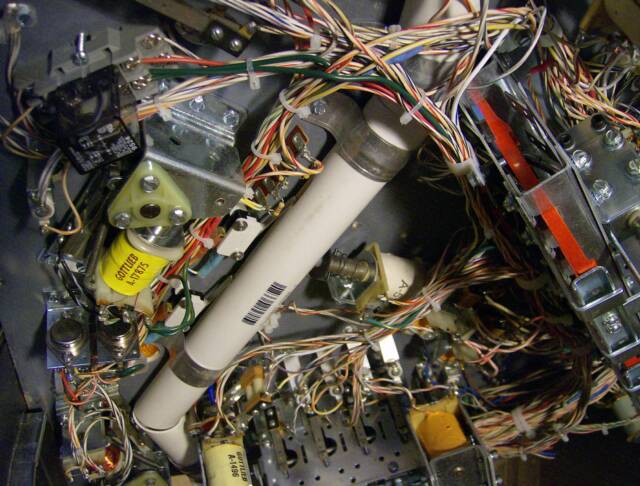Critical Mass was made by Jim Capp, Joe Cicak and Jerry Yingst at the end of 1981. This was their 2nd pinball machine prototype.
Their third prototype was Dragon's Lair.
What's left of the game is pictured here.
It was a 3 level game. Since Gottlieb was making Haunted House, designing this concept game stopped.
This is what the Critical Mass playfield looked like in December of 2001, when Jerry uncovered the game. It had been sitting in a barn since 1982. The lower playfield has a mice nest in it and a dead mouse. His little foot was pressed against the clear round window.
I took the playfield to Rick Mason, a friend of mine since high school. Rick and I copied the design from the original playfield. This took a very long time. Then Rick cut, bored, and slotted every detail into the new playfield surface and gave it back to me.
All parts including lamp sockets, switches, flippers, and boards were put into place. The hard part of designing the game had already been done but I added more features and cleaned up some areas.
Take the playfield, flip it upside down, plug and mask every hole, and primer the underside.
Let the wiring begin. Original Gottlieb color coded wire was used from other playfields.
As I wired each item, I updated the schematics, just in case I have to troubleshoot this game down the road. Yes, I made a complete manual for this game.
I printed out each letter onto cardstock, then cut out each letter and detail using a steel ruler and razor blades. The cabinet was painted blue, then the black 'ball and stick' atoms were added and finally the name in white. The original cabinet did not have any artwork, but was built in a James Bond cabinet.
The backglass layout was done by myself. It was a hand drawn sketch of where the display cutouts had to be, the spinning atom, and twords like Game Over. The artwork design was done by Bob Narber on his computer. He came up with the design just by talking to me on the phone for 5 minutes. The original artwork for the backglass is in Jerry's pile of paperwork somewhere. From what he told me, there wasn't much to go off of anyway, but it featured a female sitting at a computer with big boobs and a lab tech standing behind her. The lab guy had one eye looking at her cleavage while the other eye was looking at the extra smoke escaping from a cooling tower outside.
Since I ran out of code for the game, I purchased a PLC, programmed it, and wired it to various devices such as lamp chaser boards, relays, solenoids, and sound boards. (PLC stands for Programmable Logic Controller) For the Transformer board, each item was stripped down, cleaned, and remounted.
Notice the blue cooling fan on the left, the 3rd speaker, and the 3 volume pots with chrome knobs.
This is the playfield before it was stripped down for clearcoating. The plastics are not pictured. The metal rails and guides were sent out for chrome plating.
This is the playfield after clearcoating. Bill Heatherly did an awesome job clearcoating this whitewood playfield.
Here is a story about Critical Mass. A Pinball Machine that had a chance to be a production game. However, the game was returned from Gottlieb back to it's owners, and they started other projects.
Since there are plenty of pinball people out there, and you probably were not able to make it to the White Rose Gameroom Show 2006, 2011, 2016, or 2024 to see the game, sit back and take a few minutes to check out this page. If you have a question about the machine please email me, Eric Selak, at blackholepinball@yorkinternet.net Thank you for visiting this page. (A of couple questions are listed at the bottom of this page.)
Links provided throughout this page to hear and see more!
Copyright 2006 - todays date, Eric Selak blackholepinball@yorkinternet.net
Photographs used with permission from Jerry Yingst, Joe Cicak, and Richard Mason.
The photographs may not be used for any publication without permission. Please ask first.
Audio should not reproduced without permission. Again, please ask first.
Gottlieb, the Gottlieb Logo, and the "G" are registered trademarks and copyrighted by
Gottlieb Development LLC.
The circuit boards are original equipment. Small programming changes and modifications allowed me to get the sound effects I wanted. Unfortunately, it took 3 sound/speech boards for me to be satisfied.
Below is a homemade modification for the driver board, to allow communication between the PLC and other sound cards.
Click Play above to hear the original "speech" line, when I tested the original sound board found in the bottom of the game.
(Since speech was difficult to understand at the time, the line is: "Shoot Extra Mass")
At the 2006 White Rose Gameroom Show, 2 of the 3 designers came to the show to see the finished pinball machine.
We talked for hours and it brought back a lot of memories for these guys.
Jerry Yingst (left) and Jim Capp (right). Dudley Gorden also came along but he took the pictures! He was part of the group from the start but wasn't around when they got to Critical Mass. Too bad Joe Cicak didn't make it. It would have been nice to get a group picture.
Their first prototype was Black Hole.
Gottlieb produced 8774 BH machines in October 1981.
When you build a prototype and Gottlieb purchases it, you tend to build other prototype machines. Critical Mass was one of them.
Speaking of the manual, here is page 35.
During the unveiling of the game at the 2006 show I was finally able to put the playfield up all the way. Because of low ceiling clearance, I could never do this before.
Things to look for - PVC tubes used as subways and ball shooter lane, 8 bank drop target assembly, lower playfield on sliding rods so it can be lowered for cleaning.
Everyone usually asks me how many people or companies were involved with the actual rebuilding of the game, how long did it take to restore, and how much did it cost you?
Well, I'm not telling you how much the game cost me to rebuild. Let's just say it was a lot!
It took 5 years off and on in my spare time to complete and over 1600 hours.
People involved:
Richard Mason
Bill Heatherly
Bob Narber
and of course myself - Eric Selak
Companies involved:
Myer's Sheet Metal / Kampel Enterprises
The Pinball Resource
Gottlieb Development L.L.C.
Impressive Signs
Plastic Fabricators of York, Inc.
Lion Tool and Design
G&G Metal Finishing
Pinball Parts Plus
This is the complete working game.
It is an official Gottlieb prototype. Gottlieb trademarks are used with their permission. It's the only one that exists.
Other details about this machine can be found at the Internet Pinball Database.
Earlier on this web page, I mentioned about making a manual for this game just in case I needed to trouble-shoot problems down the road. Well, for the first time in March 2009 the game had major problems. Resorting to the manual helped and the problem was fixed. Another first was cleaning both playfields. While I had the game apart for cleaning I decided to take some under the playfield shots and close-ups. Enjoy.
TNT Amusements Todd Tuckey was granted full access to video this machine. Also in the video Todd interviews myself and Jerry Yingst. Jerry helped design both machines in the early 1980s and shares his insights.
Not to go off the beaten path, but I though it would be interesting to note some names of other games from 1981 to 1982 that, for some reason or another, did not make it into production.
John Trudeau was the designer for many of these prototype machines. Those games that show a game number did make it into production.
In 2024 I visited the Pintastic Pinball and Gameroom Expo in Massachusetts. I did an hour long seminar showing the complete history of the game including where it all started. If you want to hear me talk for an hour, the seminar can be found on YouTube at
https://www.youtube.com/watch?v=zBzCaBQSHbA
(copy and paste into browser please)
5 Years after it's debut at the Show, and almost 10 years since I started the project, Critical Mass got some new speech. There are two custom programmed EPROMs. This does not violate my agreement with Gottlieb Development LLC because the game still uses the same sound/speech board from the 1980s.
Apart from "Shoot extra mass" above, seven more speech lines were added.
Only three of them are useful. They are used in attract mode only.
It would have taken another sound/speech board and another PLC to make it work perfect.
Well, I'm not up for the challenge anymore in 2015. In fact, I don't think I have any more room left in the cabinet. I'm just glad the game is finished and has speech.
Q: Is the game for sale?
A: No. This game is officially licensed by Gottlieb. Per the agreement the game cannot be sold. The game can be taken to shows and the game can go to a non-profit organization.
Q: What are your plans for the game?
A: I've been trying to donate the game to the Pinball Hall of Fame for several years now.
As of Mother's Day 2025, the game now resides at the Roanoke Pinball Museum in Roanoke VA
Visit:
https://roanokepinball.org/
